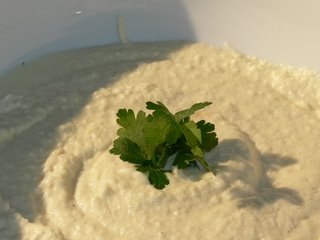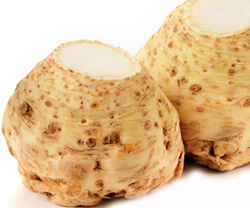 These days, few of the vegetables you’ll find in the supermarket are truly seasonal. We’ve got year-round mange tout peas (I remember the days when my parents grew them in the garden – the season only lasted for about about a month, but my, were we sick of peas at the end of that month); year-round broccoli and year-round cauliflower. Spring cabbage appears in the shops in summer, autumn and winter, and out-of-season asparagus is there whenever you want it. It doesn’t taste of anything, but if you want it, it’s there.
These days, few of the vegetables you’ll find in the supermarket are truly seasonal. We’ve got year-round mange tout peas (I remember the days when my parents grew them in the garden – the season only lasted for about about a month, but my, were we sick of peas at the end of that month); year-round broccoli and year-round cauliflower. Spring cabbage appears in the shops in summer, autumn and winter, and out-of-season asparagus is there whenever you want it. It doesn’t taste of anything, but if you want it, it’s there.
Happily for those outraged by man’s twisting of nature, here are a few season-specific things that you won’t find all year round. Some English root vegetables in particular are only easy to find in the winter (for the most part – there’s always bound to be someone bussing turnips in from Australia in high summer), and they’re wonderful in the cold months. It makes sense really – these roots are the energy store of the plants, and so they’re full of sugars and other nutrients.
Celeriac is one of my favourite winter roots. It’s the taproot of a celery plant (not the same one you use to dip in your hummus or to stir your Bloody Mary), but tastes much richer, deeper, creamier and sweeter than celery. I know people who can’t bear celery, but who will happily munch on celeriac; they’re really very different flavours. This vegetable isn’t readily found outside Europe, but if you are an American reader and happen upon one in a market, snap it up so you can impress your friends with your cosmopolitan cooking.
Although modern ‘best before’ stickers tend to suggest you can only keep your celeriac for a week or so, the root will actually keep in the fridge for a month or so if wrapped in plastic to keep it nice and humid- inside your fridge it is dark and cold, which fools the root into thinking it’s still underground – the celeriac won’t be any the worse for it.
 The celeriac is a knobbly, rough-skinned vegetable, and its flesh is very hard. Make sure you have a very sharp knife to remove all the skin and nubbly bits, and to cut through the solid root. It makes a lovely soup (which I really ought to blog some time), and it’s great raw in coleslaw. One of the very nicest of French crudités is simply grated raw celeriac blended with a little home-made mayonnaise. But for my money, one of the best things you can do with a chunk of celeriac is to cook it until soft, mash it with a little potato, push the resulting mixture through a sieve and whip it with butter and cream for a very fine and rich side dish.
The celeriac is a knobbly, rough-skinned vegetable, and its flesh is very hard. Make sure you have a very sharp knife to remove all the skin and nubbly bits, and to cut through the solid root. It makes a lovely soup (which I really ought to blog some time), and it’s great raw in coleslaw. One of the very nicest of French crudités is simply grated raw celeriac blended with a little home-made mayonnaise. But for my money, one of the best things you can do with a chunk of celeriac is to cook it until soft, mash it with a little potato, push the resulting mixture through a sieve and whip it with butter and cream for a very fine and rich side dish.
To make celeriac purée as an accompaniment for four, you’ll need:
1 large celeriac, about 20 cm in diameter (anything larger than this may be a bit woody)
2 medium potatoes (choose a variety which is good for mashing)
100 ml double cream
2 heaping tablespoons salted butter
2 level teaspoons salt (plus more to taste)
Using a very sharp knife, peel the celeriac and cut it into 2 cm square chunks. As soon as you have cut a piece, put it in a saucepan of cold water to stop it from oxidising and turning brown. Peel the potatoes and cut them into chunks about twice the size of the celeriac pieces, and add them to the pan. Warm a mixing/serving bowl.
Bring the potatoes and celeriac to the boil, put the lid on the pan and simmer for 15 minutes. Poke the vegetables with a fork to check they are soft (if they are not, cook for another 5 minutes). Drain and use a potato masher to mash the celeriac and potatoes until they are as even as you can manage.
Melt the butter and cream together in a milk pan, and bring to a very low simmer as you sieve the purée.
Push the mashed mixture through a sieve using the back of a ladle. You can also use a mouli or food mill if you have one. The resulting purée will be extremely smooth. Put the purée into the warmed bowl and use a hand whisk to whip the butter and cream mixture into the purée with the salt, and serve immediately. This is particularly good with rich meat dishes and roasts.
This is a kind of rösti, which I came up with to accompany some jerked chicken. Plantains are great: they are a cousin of the banana, and look like a giant, green, yellow or creamy version of the things you eat for pudding. Unlike a banana, a plantain is usually served cooked, either when under-ripe, when they are wonderfully starchy, or overripe, when they become sweet.

